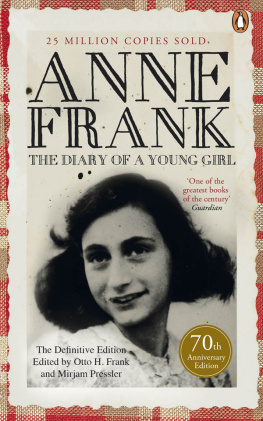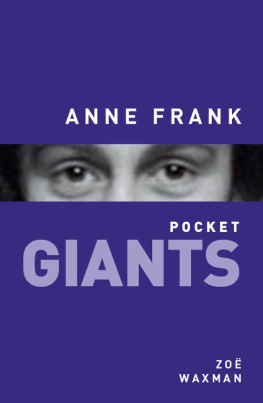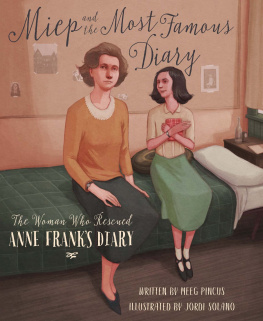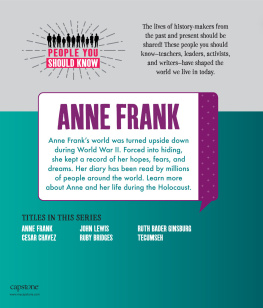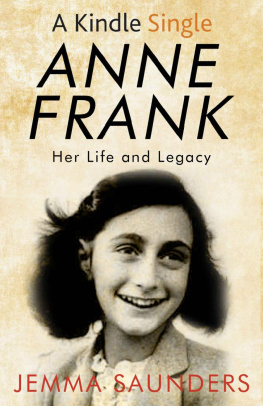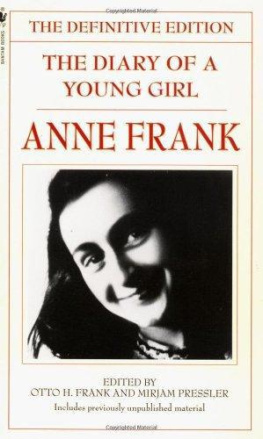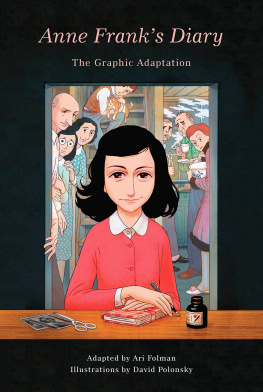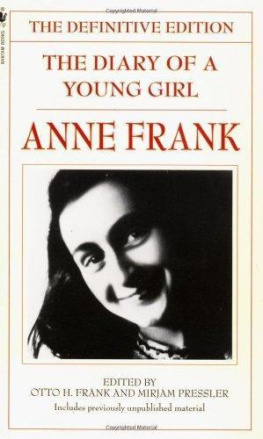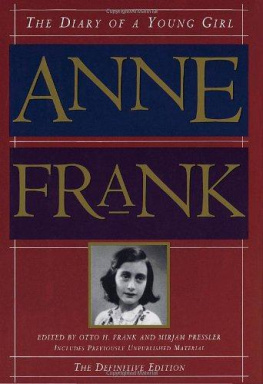PENGUIN BOOKS
The Diary of a Young Girl
Fifty years have passed since Anne Franks diary was first published. Her story came to symbolize not only the travails of the Holocaust, but the struggle of the human spirit in adversity ... Bergen-Belsen was liberated by British troops in April 1945. One of them wrote to me recently: I was too late to save Anne Frank. That shows the impact that her story has made, and will continue to make. This edition is a worthy memorial Martin Gilbert, The Times
A monument to the human spirit
Phillip Knightley, Mail on Sunday
This edition will shine a new light on Anne Frank for those who have read the original diary. And for readers new to her, including young people who are the age she was when she started writing, it will be an immensely powerful and enjoyable introduction to the multi-faceted person that she was and the world that she inhabited Reva Klein, The Times Educational Supplement
Susan Massotty captures Annes innocent cockiness, her sense of fun, she sweetness of the lonely adolescent There are a lot of lessons to be learnt from reading this beautiful book Gaia Servadio, Observer
A witty, funny and tragic book Annes gift, her early death, her Jewishness, are tailormade for the sainthood. The miracle is her diary. It flourished in the shadow of death, its author died at Belsen and yet it survived New version or old, this extraordinary book stands on its own even without its context of horror Silvia Rodgers, Sunday Times
Anne Frank was born on 12 June 1929. She died while imprisoned at Bergen-Belsen, three months short of her sixteenth birthday.
Otto H. Frank was the only member of his immediate family to survive the Holocaust. He died in 1980.
Mirjam Pressler is a popular, prize-winning writer of books for young readers and a well-known translator. She lives in Germany.
The translator, Susan Massotty, lives in Holland.
The Diary of a Young Girl
THE DEFINITIVE EDITION
Anne Frank
Edited by OTTO H. FRANK and MIRJAM PRESSLER
Translated by SUSAN MASSOTTY
PENGUIN BOOKS
PENGUIN BOOKS
Published by the Penguin Group
Penguin Books Ltd, 80 Strand, London WC2R 0RL , England
Penguin Group (USA) Inc., 375 Hudson Street, New York, New York 10014, USA
Penguin Group (Canada), 90 Eglinton Avenue East, Suite 700, Toronto, Ontario,Canada M4P 2Y3
(a division of Pearson Penguin Canada Inc.)
Penguin Ireland, 25 St Stephens Green, Dublin 2, Ireland
(a division of Penguin Books Ltd)
Penguin Group (Australia), 250 Camberwell Road, Camberwell, Victoria 3124,Australia (a division of Pearson Australia Group Pty Ltd)
Penguin Books India Pvt Ltd, 11 Community Centre, Panchsheel Park, New Delhi 110 017, India
Penguin Group (NZ), 67 Apollo Drive, Rosedale, North Shore 0632, New Zealand
(a division of Pearson New Zealand Ltd)
Penguin Books (South Africa) (Pty) Ltd, 24 Sturdee Avenue, Rosebank, Johannesburg 2196, South Africa
Penguin Books Ltd, Registered Offices: 80 Strand, London WC2R 0RL , England
www.penguin.com
First published in the United States of America by Doubleday 1995
First published in Great Britain by Viking 1977
Published in Penguin Books 1977
Reprinted with further previously unpublished material by Doubleday 2001
Published in Penguin Books 2001
This edition with new Read More material published in penguin Books 2007
Copyright The Anne Frank Fonds, Basle, Switzerland, 1991, 2001
English translation copyright Doubleday, a division of Random House Inc., 1995, 2001
Photographs copyright The Anne Frank Fonds, Basle, Switzerland, Anne Frank Stichting; Christopher Knoch
Read More-material Clare Garner, 2007
All rights reserved
The moral right of author has been asserted
Except in the United States of America, this book is sold subject to the condition that it shall not, by way of trade or otherwise, be lent, re-sold, hired out, or otherwise circulated without the publishers prior consent in any form of binding or cover other than that in which it is published and without a similar condition including this condition being imposed on the subsequent purchaser.
ISBN: 978-0-14-197166-7
Contents
Foreword
Anne Frank kept a diary from 12 June 1942 to 1 August 1944. Initially, she wrote it strictly for herself. Then, one day in 1944, Gerrit Bolkestein, a member of the Dutch government in exile, announced in a radio broadcast from London that after the war he hoped to collect eyewitness accounts of the suffering of the Dutch people under the German occupation, which could be made available to the public. As an example, he specifically mentioned letters and diaries.
Impressed by this speech, Anne Frank decided that when the war was over she would publish a book based on her diary. She began rewriting and editing her diary, improving on the text, omitting passages she didnt think were interesting enough and adding others from memory. At the same time, she kept up her original diary. In the scholarly work The Diary of Anne Frank: The Critical Edition (1989), Annes first, unedited diary is referred to as version a, to distinguish it from her second, edited diary, which is known as version b.
The last entry in Annes diary is dated 1 August 1944. On 4 August 1944, the eight people hiding in the Secret Annexe were arrested. Miep Gies and Bep Voskuijl, the two secretaries working in the building, found Annes diaries strewn all over the floor. Miep Gies tucked them away in a desk drawer for safekeeping. After the war, when it became clear that Anne was dead, she gave the diaries, unread, to Annes father, Otto Frank.
After long deliberation, Otto Frank decided to fulfil his daughters wish and publish her diary. He selected material from versions a and b, editing them into a shorter version later referred to as version c. Readers all over the world know this as The Diary of a Young Girl.
In making his choice, Otto Frank had to bear several points in mind. To begin with, the book had to be kept short so that it would fit in with a series put out by the Dutch publisher. In addition, several passages dealing with Annes sexuality were omitted; at the time of the diarys initial publication, in 1947, it was not customary to write openly about sex, and certainly not in books for young adults. Out of respect for the dead, Otto Frank also omitted a number of unflattering passages about his wife and the other residents of the Secret Annexe. Anne Frank, who was thirteen when she began her diary and fifteen when she was forced to stop, wrote without reserve about her likes and dislikes.
When Otto Frank died in 1980, he willed his daughters manuscripts to the Netherlands State Institute for War Documentation in Amsterdam. Because the authenticity of the diary had been challenged ever since its publication, the Institute for War Documentation ordered a thorough investigation. Once the diary was proved, beyond a shadow of a doubt, to be genuine, it was published in its entirety, along with the results of an exhaustive study. The Critical Edition contains not only versions a, b and c, but also articles on the background of the Frank family, the circumstances surrounding their arrest and deportation, and the examination into Annes handwriting, the document and the materials used.

